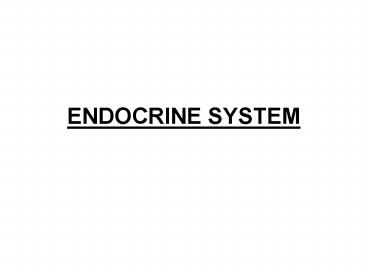ENDOCRINE SYSTEM - PowerPoint PPT Presentation
Title:
ENDOCRINE SYSTEM
Description:
ENDOCRINE SYSTEM Mechanisms of Chemical Signaling: a Review Control Pathways and Feedback Loops There are three types of hormonal control pathways One Chemical Signal ... – PowerPoint PPT presentation
Number of Views:555
Avg rating:3.0/5.0
Title: ENDOCRINE SYSTEM
1
ENDOCRINE SYSTEM
2
Mechanisms of Chemical Signaling a Review
Water-Soluble/Nonsteroid Hormones
Lipid-Soluble/Steroid Hormones
3
Control Pathways and Feedback Loops
- There are three types of hormonal control
pathways
4
One Chemical Signal, Different Effects
5
ENDOCRINE GLANDS
- Are ductless and secrete hormones directly into
the bloodstream - Target Cells the cells that a hormone directly
affects - if a cell does not have receptors or the
receptors dont respond, the hormone has no
effect.
6
Human Endo-crine Glands
7
- Most hormones operate by a negative feedback
system or feedback inhibition a - stimulus produces a response that opposes the
original stimulus an environmental change feeds
back to inhibit the original stimulus.
8
The Reproductive Cycle of the Human Female
9
THYROID GLAND
- Located in the neck, is the target gland of
thyroid-stimulating hormone (TSH) - When the thyroid is stimulated by TSH it releases
the hormones Triiodothyronine (T3) and Thyroxine
(T4), which regulates the metabolic rate of your
body tissues
10
Feedback control loops regulating the secretion
of thyroid hormones T3 and T4
11
PARATHYROID GLANDS
- These are four pea-shaped organs that rest on the
thyroid. They secrete parathyroid hormone which
increases blood calcium levels the opposite
effect of what calcitonin does
12
An example of how feedback regulation maintains
homeostasis
13
THE PITUITARY GLAND
- Often called the master gland because it
secretes so many hormones (9 total!) - Has two parts Anterior Pituitary and Posterior
Pituitary
14
Remember the acronym MAP TO FLAG to
remember the nine pituitary hormones
15
- The pituitary sits just below the hypothalamus
which regulates the anterior pituitary by
secreting neurosecretory hormones that can
stimulate or inhibit the actions of it
16
Hormones of the hypothalamus and pituitary glands
Nerve cells that release hormones into the blood
17
ANTERIOR PITUITARY
- Secretes seven hormones
- Growth Hormone (GH) stimulates bone and muscle
growth - Adrenocorticotropic Hormone (ACTH) stimulates the
adrenal cortex to secrete hormones
(corticosteroids)
18
ADRENAL CORTEX
- ACTH causes the adrenal cortex to produce its
different hormones - Glucocorticoids target the liver and promote
the release of glucose
19
Adrenal Cortex
- Mineralcorticoids target the kidney and promote
the retention of water - Ex Aldosterone increases recovery of Na and
increases excretion of K and H ions into the
urine
20
Thyroid-Stimulating Hormone (TSH)
Anterior Pituitary Gland
- Stimulates the thyroid to secrete thyroxine
- Follicle-Stimulating Hormone (FSH)
- Stimulates the follicle to grow in females,
oogenesis, and spermatogenesis
21
Luteinizing Hormone
Anterior Pituitary Gland
- Causes the release of the ovum during the
menstrual cycle in females and testosterone
production in males
22
Prolactin
Anterior Pituitary Gland
- Stimulates the mammary glands to produce milk
23
Anterior Pituitary Gland
Melanocyte-Stimulating Hormone (MSH) Regulates
skin color in lower vertebrates, although its
function in humans is unknown
24
Posterior Pituitary Gland
- Secretes Two Hormones (made by hypothalamus)
- Antidiuretic Hormone (ADH)
- acts on the kidneys, increasing
- water retention and thus decreasing urine volume.
25
Posterior Pituitary Gland
- Oxytocin is secreted by the stimulation of the
nipples - during breast feeding and sexual intercourse it
also stimulates uterine contractions during labor
26
ADRENAL GLANDS
- Adrenal Medulla secretes epinephrine
(adrenaline) and norepinephrine(noradrenaline)fig
ht-or-flight response increase HR, BP,
metabolism, etc
27
Glucose homeostasis maintained by insulin and
glucagon
28
THE PANCREAS
- Glucagon stimulates the liver to convert
glycogen into glucose and to release that glucose
into the blood - Insulin has the opposite effect of glucagon
29
Major Vertebrate Endocrine Glands and Some of
Their Hormones
30
Major Vertebrate Endocrine Glands and Some of
Their Hormones (PancreasThymus)
31
What is the advantage of having both a nervous
system and an endocrine system? What does the
hormone thyroxine affect?
32
What is one effect of an iodine deficient diet?
Insulin stimulates cell to remove sugar from
the blood while ___________ stimulates the
release of glucose from cells.
33
A shortage of dietary iodine makes it impossible
for the thyroid gland to produce thyroxine.
What would happen to blood levels of
thyroxine and the thyroid gland as a result? The
role of ADH is to
34
What is the difference between Type I and Type II
diabetes?
35
- The thyroid also increases the concentration of
calcitonin which decreases the bloods
concentration of calcium.































